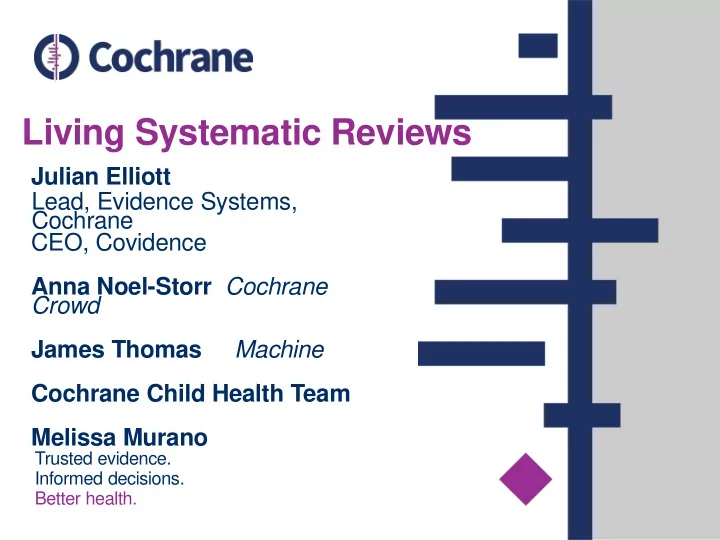

Living Systematic Reviews Julian Elliott Lead, Evidence Systems, Cochrane CEO, Covidence Anna Noel-Storr Cochrane Crowd James Thomas Machine Cochrane Child Health Team Melissa Murano Trusted evidence. Informed decisions. Better health.
Cathy Gordon, MPH Partnership Coordinator, Crowd Roger Chou, MD Living Systematic Review, Child Health Aaron Cohen, MD Machine Mark Helfand, MD Presenter
Life Cycle of a USPSTF guideline 2005 “ US Preventive Services Task Force (USPSTF) found insufficient evidence to recommend for or against routine primary care screening for overweight.” 2008 Effectiveness of Weight Management Programs in Children and Adolescents About 10 new studies by 2007 2010 Effectiveness of Primary Care Interventions for Weight Management in Children and Adolescents (USPSTF) 2010 new B recommendation (now archived)
Life Cycle of a USPSTF guideline 2014 Draft Research Plan for a new update 2017 Screening for Obesity and Interventions for Weight Management in Children and Adolescents (new USPSTF review, about 14 new trials since 2007 ) 2017 Still a B recommendation
Two New Cochrane Titles in Child Health Diet, physical activity and behavioural interventions for the treatment of overweight or obese children --from the age of 6 to 11 years. Cochrane Database of Systematic Reviews 2017 -- aged 12 to 17 years . Cochrane Database of Systematic Reviews 2017.
The reality Time from study to systematic review Elliott JH, Turner T, Clavisi O, Thomas J, et al. (2014) PLoS Med 11(2): e1001603.
Time from protocol to SR publication Tricco, PLoS ONE 2008; 3:e3684
What takes so long? Striking and pitching Surveillance for Signals Seeking, Sifting, Sorting Synthesis Peer Review Dissemination
Strategies Rapid Reviews “Brief” Products Environmental Scans, Landscapes, etc Living Systematic Reviews
What is a Living Systematic Review? A systematic review that is continually updated, incorporating new evidence as it becomes available. Key elements: • “Systematic review” (retains core methods) • “Continually” (frequency?) • “Updated” (where?) • “Incorporating new evidence” (how?)
LSR vs SR: Key differences Category Item Description Production Work processes Search strategy maintained and fed continuously into SR workflow Author team Coordinated and continuous effort management Methods LSR-specific approach to search and study incorporation is pre-specified; Potential statistical adjustments to allow for frequent updating of meta-analysis Publication Publication format Persistent, dynamic, online-only publication
LSR Project Conduct two LSRs in child health that can have an impact on policy High priority (or emerging) question for policy and practice Important uncertainty in the existing evidence Emerging evidence (e.g. in trial registers) that is likely to impact on what we currently know Network of contributors have capacity and resources to sustain an ongoing SR commitment Using these enablers: Machine learning Crowd innovation
Cochrane Crowd As with any SR, the search for evidence forms a critical component What happens here has a knock-on effect for the whole review Needed Doable tasks tasks It’s about offering needed and doable microtasks aimed at identifying and describing the evidence we need to produce our reviews
Cochrane Crowd crowd.cochrane.org | @cochrane_crowd
So far Over 1 million individual classifications! Over 5500 people have signed up to contribute Around 40,000 randomised trials have been found by Cochrane Crowd
Available Planned or in beta More tasks Identifying Describing YES P I C O Is it an RCT? YES P E C O Is it a DTA?
Development of evidence communities And you can work on topics of interest to you Watch our short animation about Cochrane Crowd: Introducing Cochrane Crowd
Evidence-aware or evidence-wary? Research funders (Culture of health culture of evidence?) Advocates Consumer groups (CUE, Consumer Union) Professional societies (and their guidelines) USPSTF Patients and caregivers (parents) Not always allies …but can identify a common goal.
Common ground and not so common ground Get new information into policy and practice faster Figure out when to stop (Simmonds) Build communities Demand better evidence Avoid unproven interventions that are likely to do harm? Use resources on things that work
Recommend
More recommend